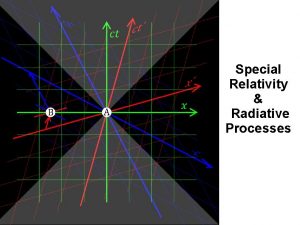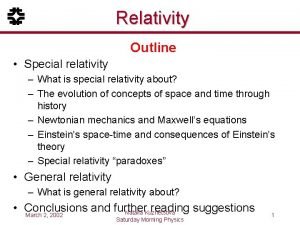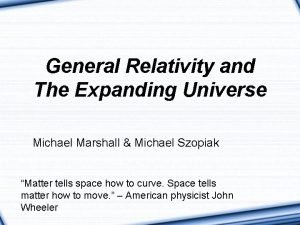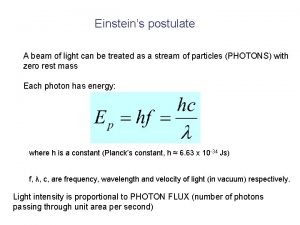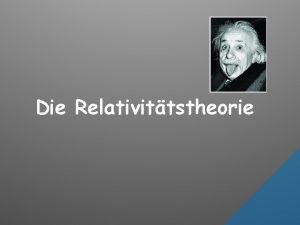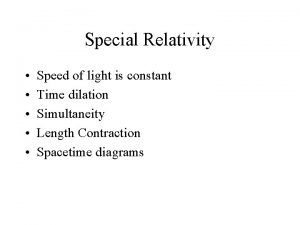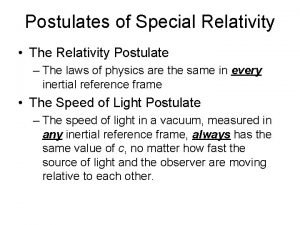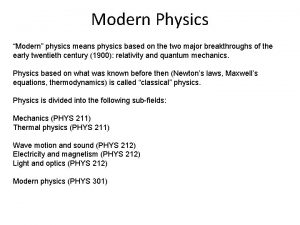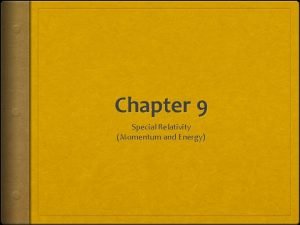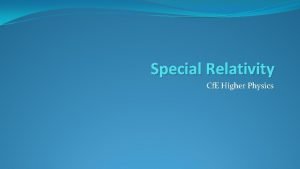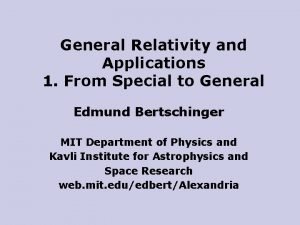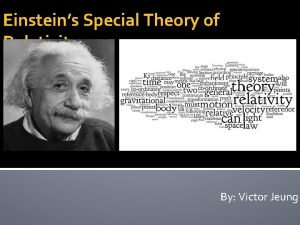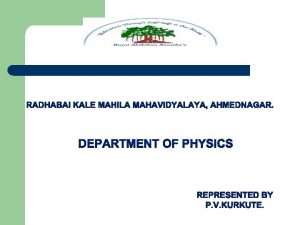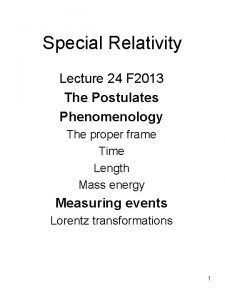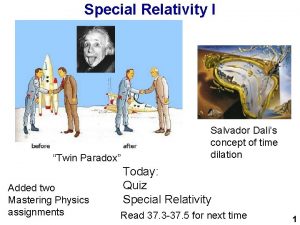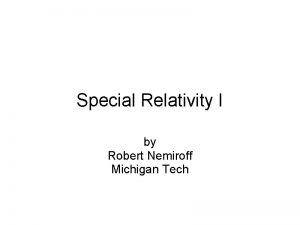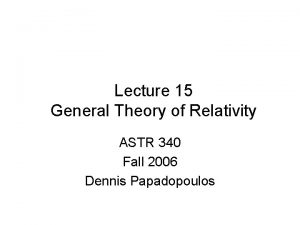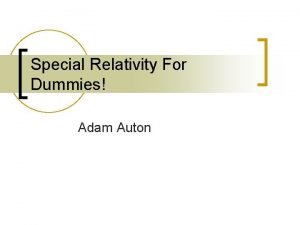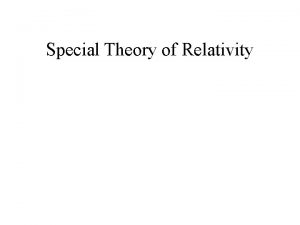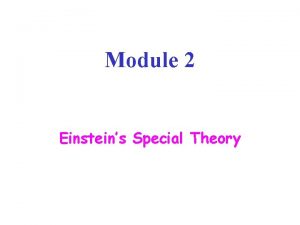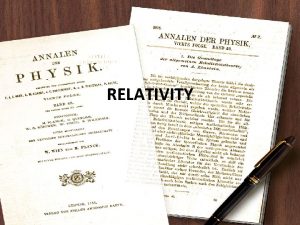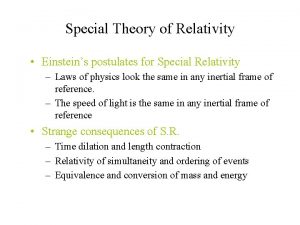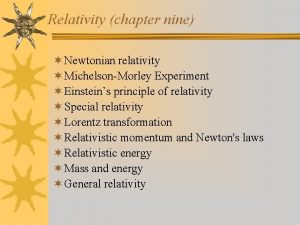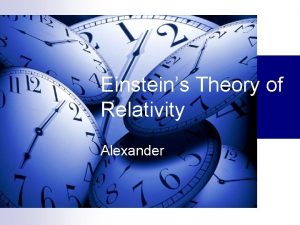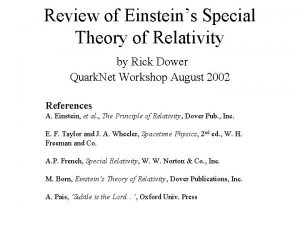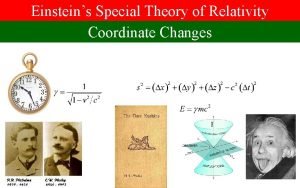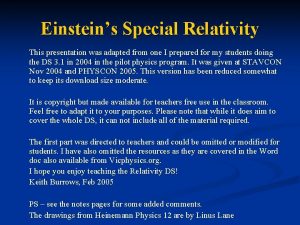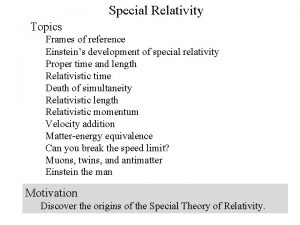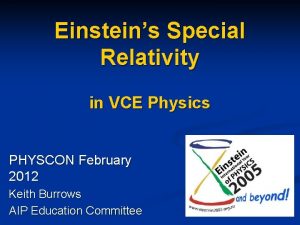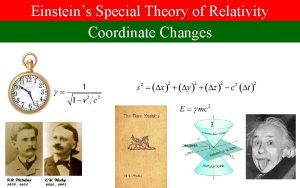Special Relativity Another Slightly Different Introduction Einsteins st




















- Slides: 20

Special Relativity: Another, Slightly Different Introduction

Einstein’s st 1 Postulate All laws of physics are the same in all inertial reference frames. So, Newton’s Laws of Motion & Maxwell’s Equations in E&M have the same mathematical form no matter what inertial frame of reference is used.

Einstein’s nd 2 Postulate The speed of light c in vacuum is a constant independent of the relative motion of the source & the observer. It doesn’t matter how fast you are going or in which direction you travel or if it is the source or the observer that is moving.

Simultaneity is Relative • Simultaneous events in one inertial reference frame won’t be simultaneous in a 2 nd inertial frame moving at constant v relative to the first frame.

Simultaneity & Lightning Flashes • Stanley sees both lightning flashes at the same time. He is midway between A & B. So, the flashes must have been emitted at the same time, in his reference frame. • Mavis sits in the middle of the train, which has moved forward in the time it takes the lightning flashes to travel to her. She sees the flash from the front of the train first, then some time later, she receives the flash coming from the back of the train.

Simultaneity & Lightning Flashes • Mavis receives the flash from the front of the train first, then some time later, she receives the flash coming from the back of the train. • Flash 1 arrives in less time than the light travel time for a distance of half the train. • Flash 2 takes more time. Mavis says The flashes were not emitted at the same time in her reference frame.

Simultaneity & Lightning Flashes • Since Mavis knows she is in the middle of the train, she would have received them at the same time if they occurred simultaneously. Both observers are correct! Both Mavis & Stanley agree that Mavis does not receive the flashes at the same time.

Time Dilation: “Moving clocks run slow” • Proper time” is the time interval between 2 events that occur at the same location in space (i. e. the time interval is measured on one clock by Mavis).

Time Dilation: “Moving clocks run slow” • Stanley measures a longer time interval for the same events. He says Mavis’ clock is running slow. They disagree on The time separation of the two events.

Time Dilation: Derivation

Lengths Perpendicular to the Motion • The “Proper length” Length of an object in its rest frame. Length of a moving object is measured by 2 observers separated in distance who measure each end at the agreed time. Lengths perpendicular to the relative motion are not contracted.

Lengths Parallel to the Motion

Derivation of Length Contraction

Derivation of Length Contraction

Observers Measure Lengths Differently • People in the spaceship measure its proper length as 400 m. Two observers on the ground measure a shorter length. People in the spaceship measure the distance between the ground observers to be shorter. All results are valid.

The Lorentz Factor • To change the spacetime coordinates of an event measured in one reference frame to those Note: is always ≥ 1 in another reference frame moving at high speed u relative to the first frame, use the Lorentz Transformation. These equations calculate how distance & time change between the 2 inertial frames.

The Lorentz Factor • The Lorentz factor ( ) tells us the strength of any relativistic effects. • Remember that c = 3 108 m/s u = 0. 1 c gives = 1. 005. u = 0. 5 c gives = 1. 15 u = 0. 99 c gives = 7. 1. Note: is always ≥ 1

Relativistic Momentum & Energy • As velocities near the speed of light, the Lorentz factor means the momentum & kinetic energy of the mass become larger & larger. The total energy also becomes huge.

Relativistic Momentum & Energy Relativistic Momentum: Relativistic Kinetic Energy: Total Energy of a particle:

Mass- Energy Equivalence • Einstein’s famous equation links energy with rest mass m 0: E 0 = m 0 2 c
 Special relativity vs general relativity
Special relativity vs general relativity Special relativity
Special relativity General relativity vs special relativity
General relativity vs special relativity Einsteins postulate
Einsteins postulate Einsteins postulate
Einsteins postulate Slightly different from
Slightly different from Special relativity
Special relativity Relativity definition
Relativity definition Inertial frame of reference
Inertial frame of reference Modern physics meaning
Modern physics meaning Momentum special relativity
Momentum special relativity Special relativity higher physics
Special relativity higher physics Special relativity summary
Special relativity summary Albert einstein theory of special relativity
Albert einstein theory of special relativity Postulates of special theory of relativity
Postulates of special theory of relativity Postulates of special theory of relativity
Postulates of special theory of relativity Special relativity
Special relativity Special relativity
Special relativity Eddington
Eddington Special relativity for dummies
Special relativity for dummies Harris burdick
Harris burdick
